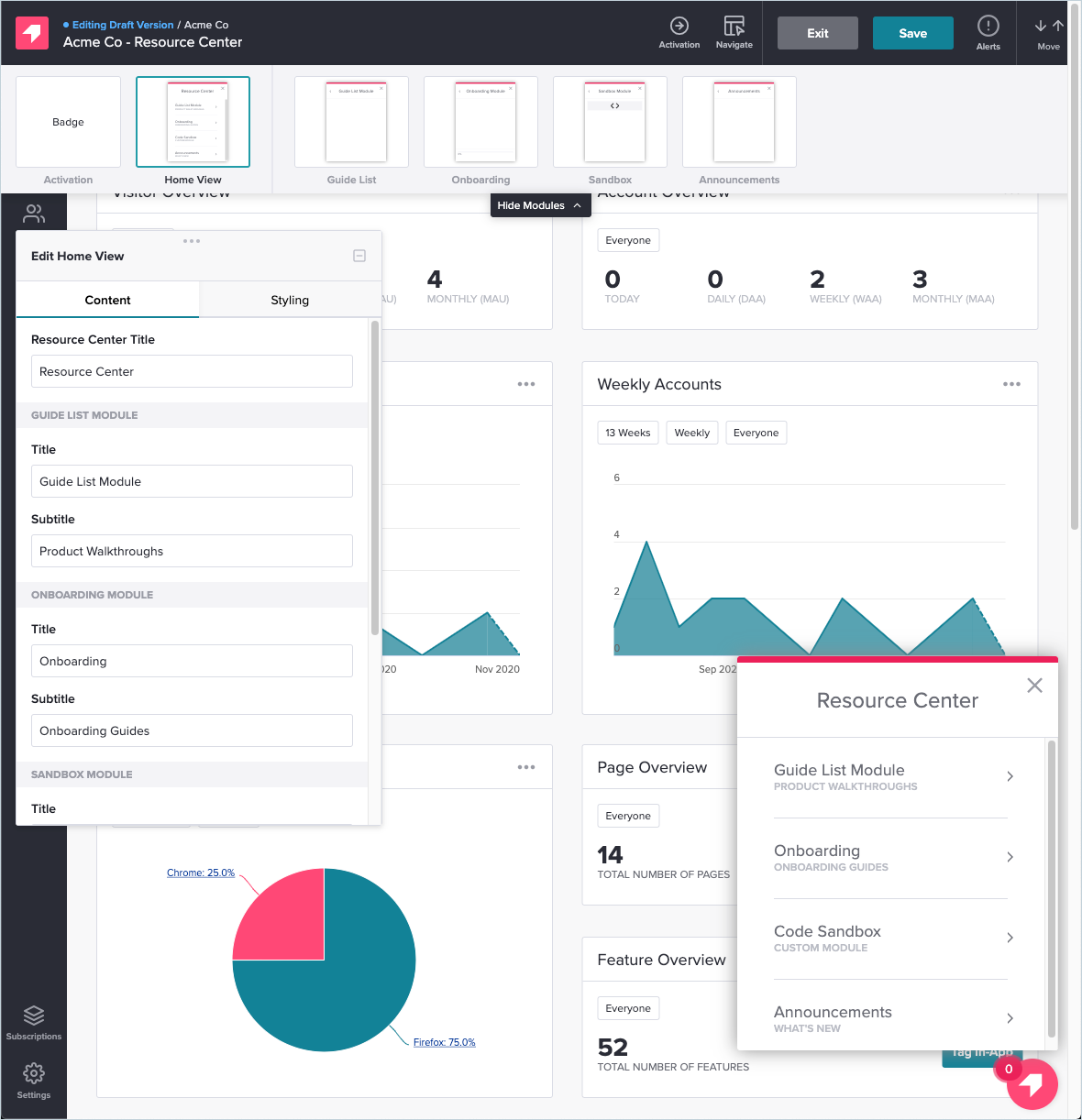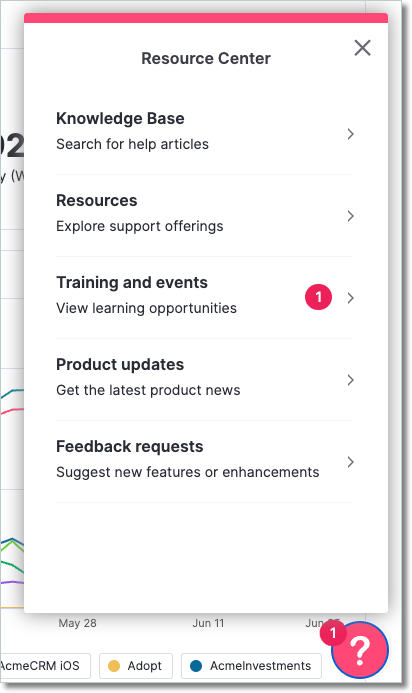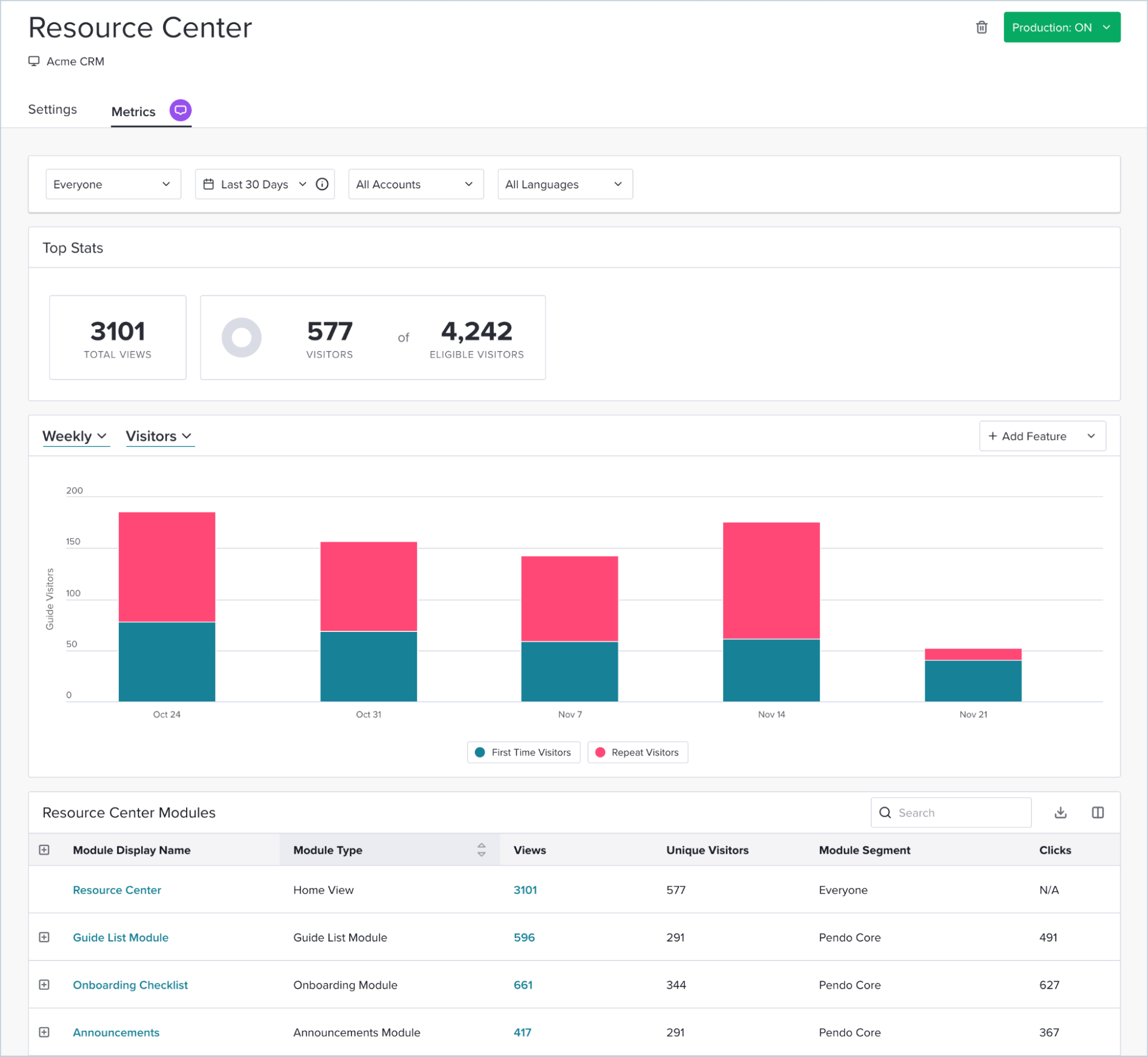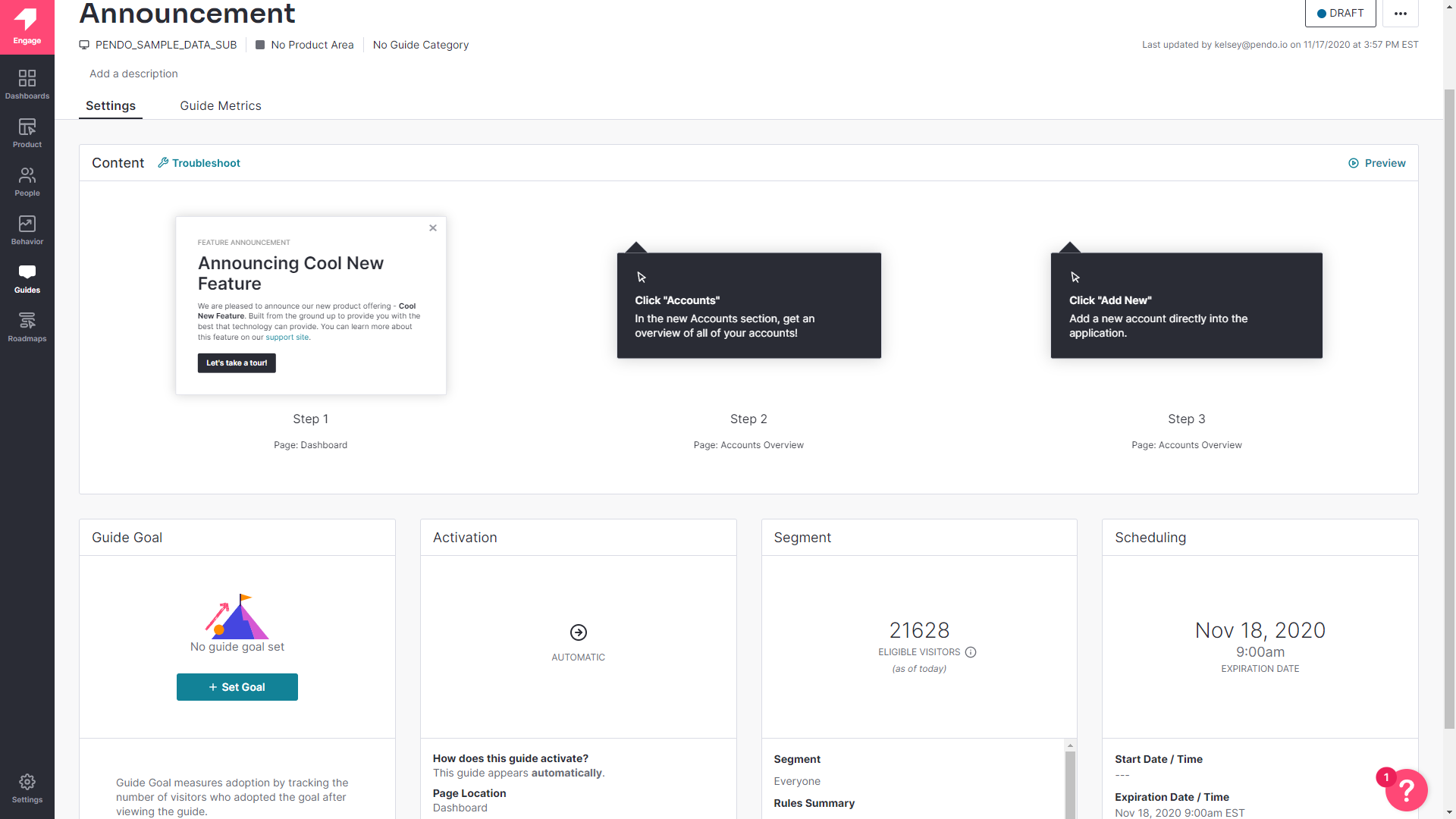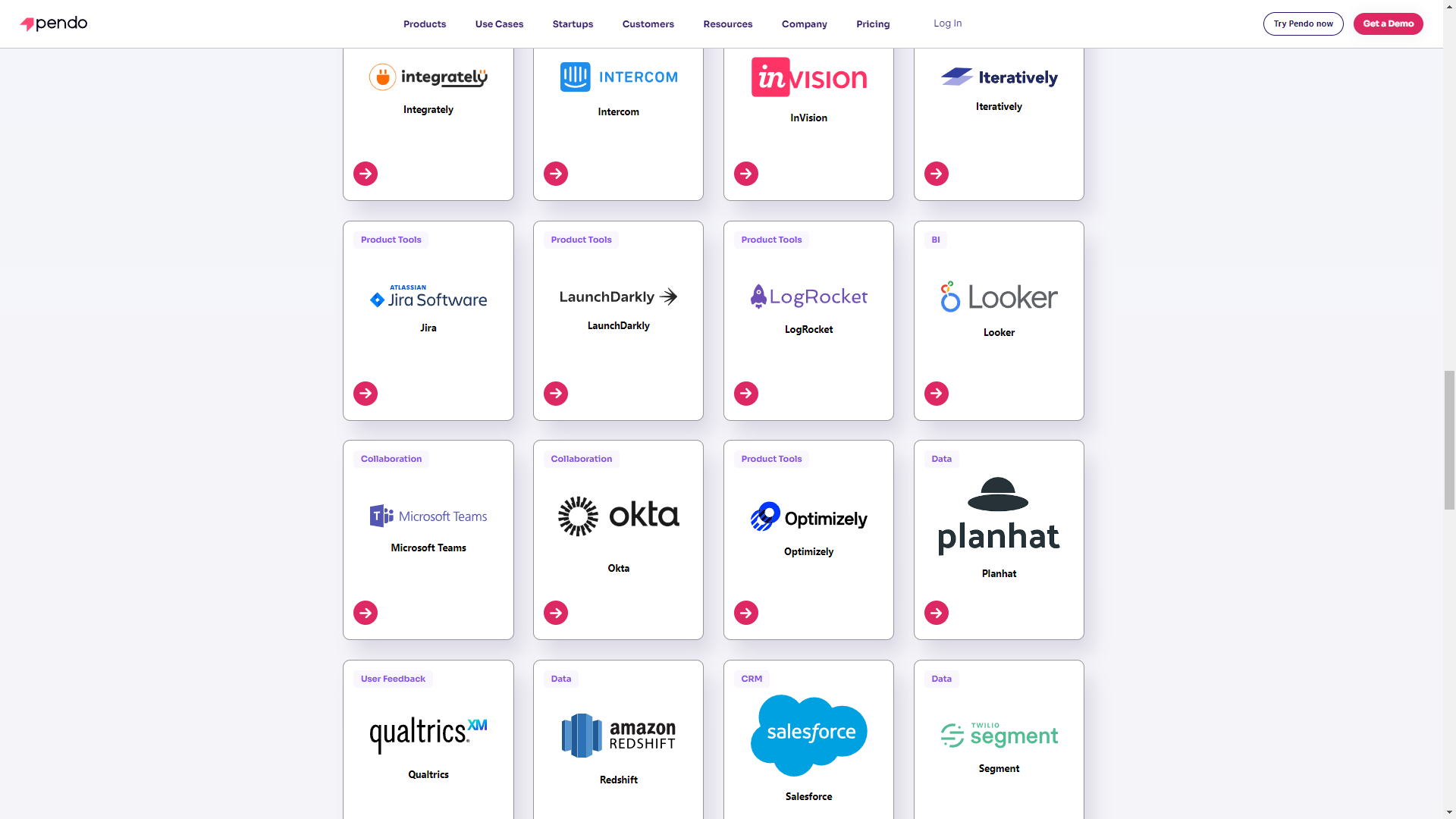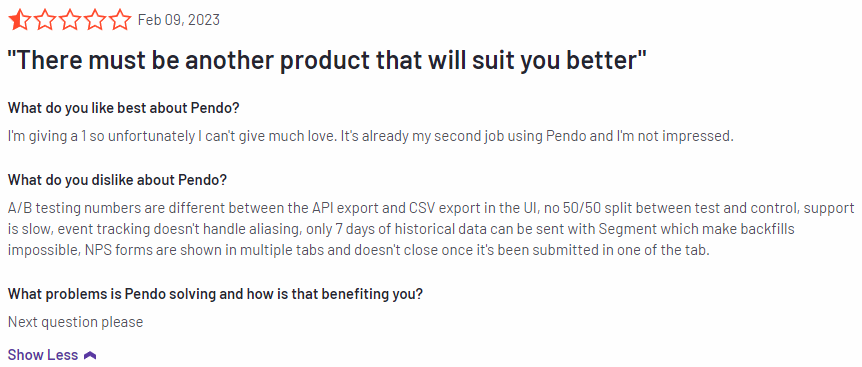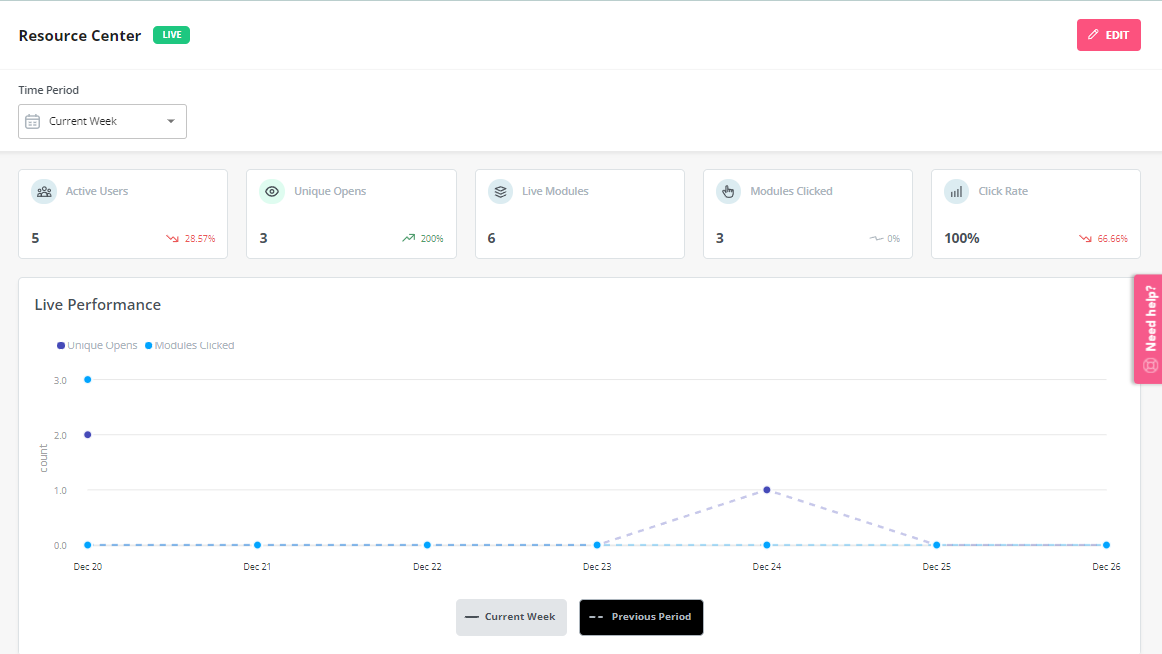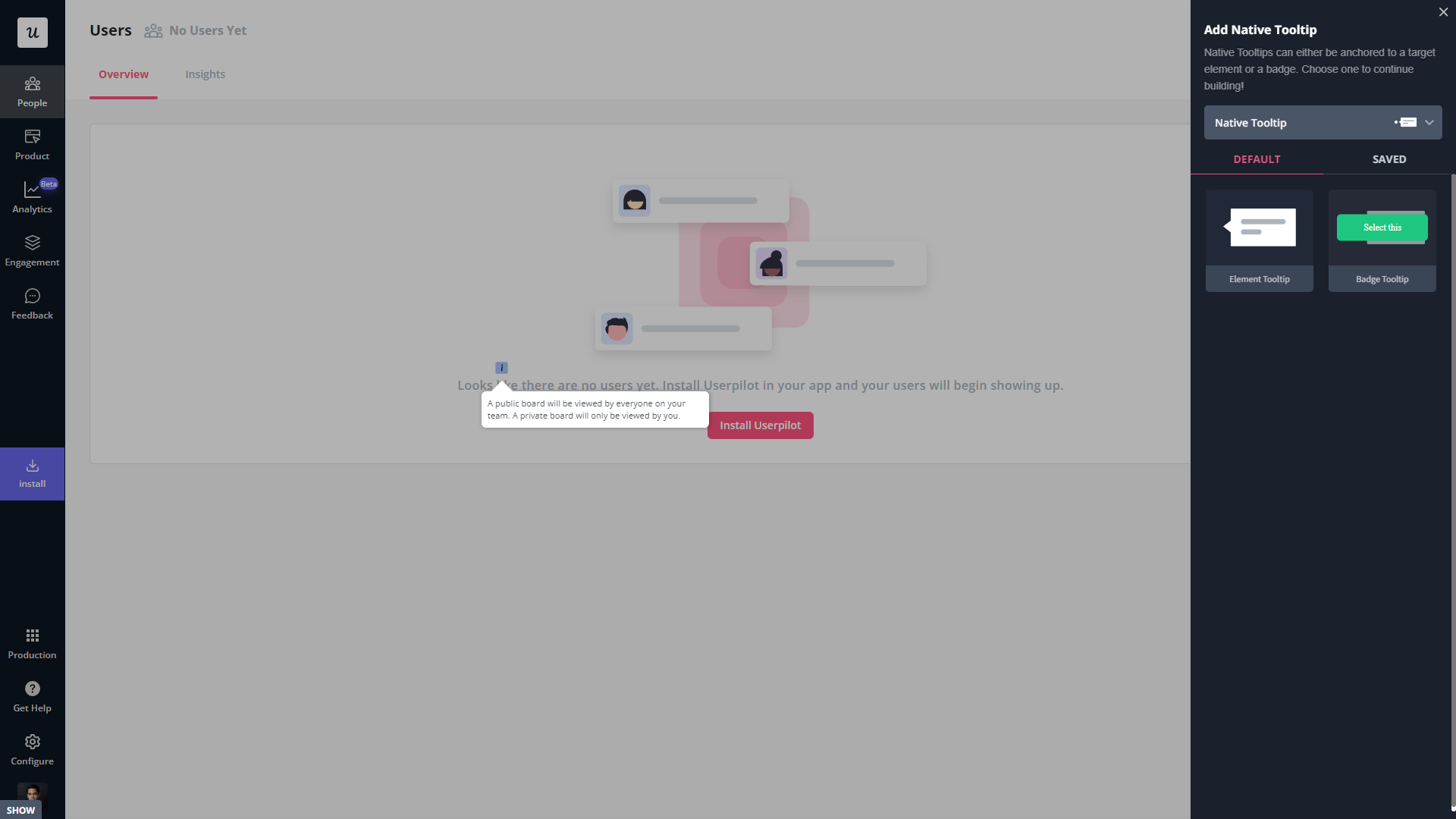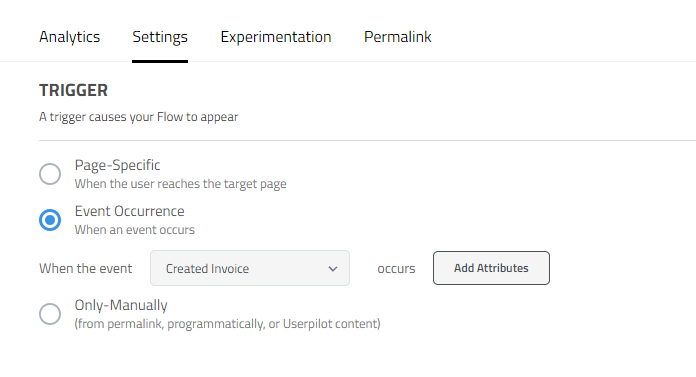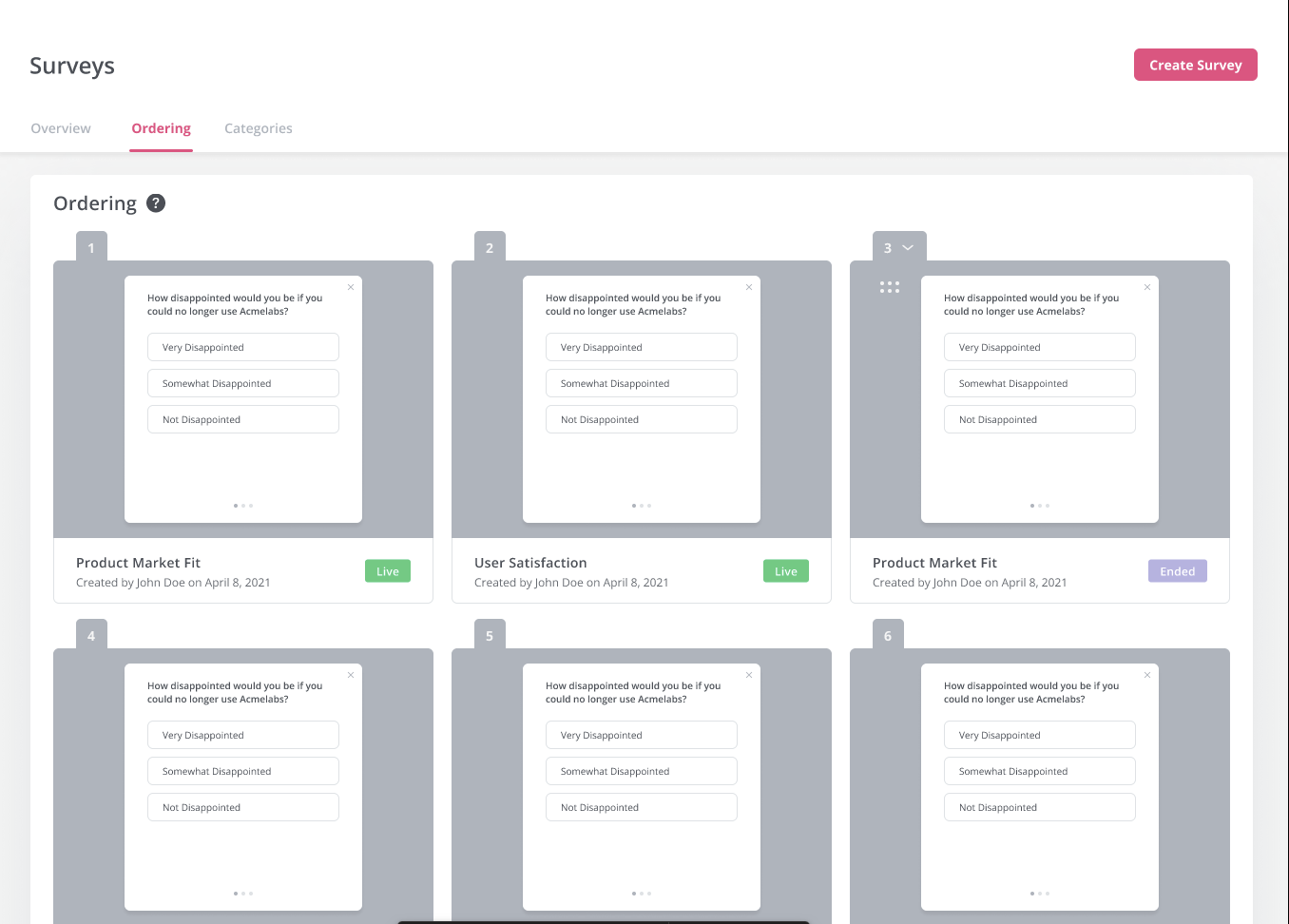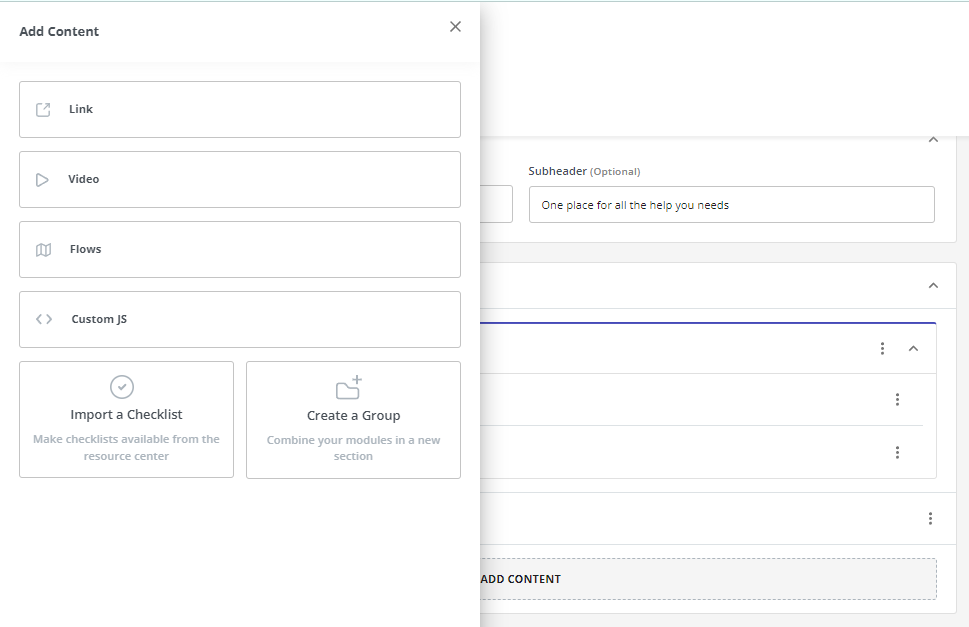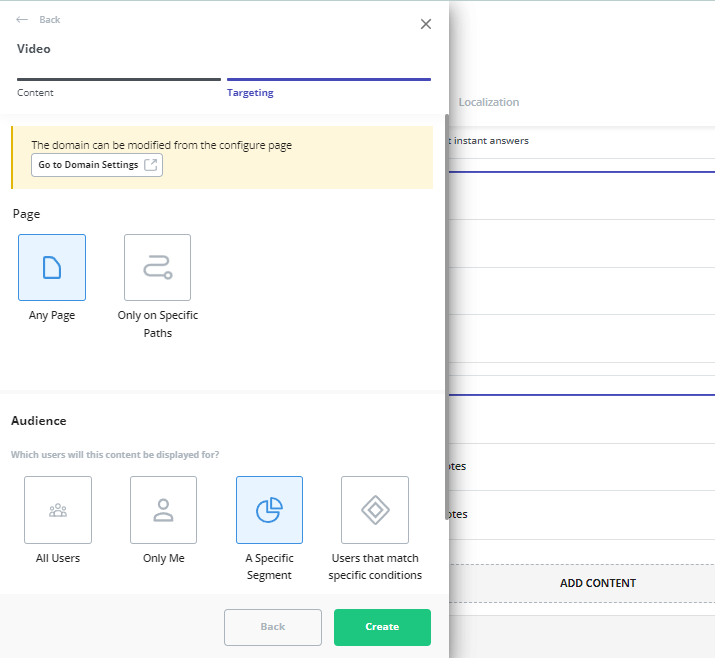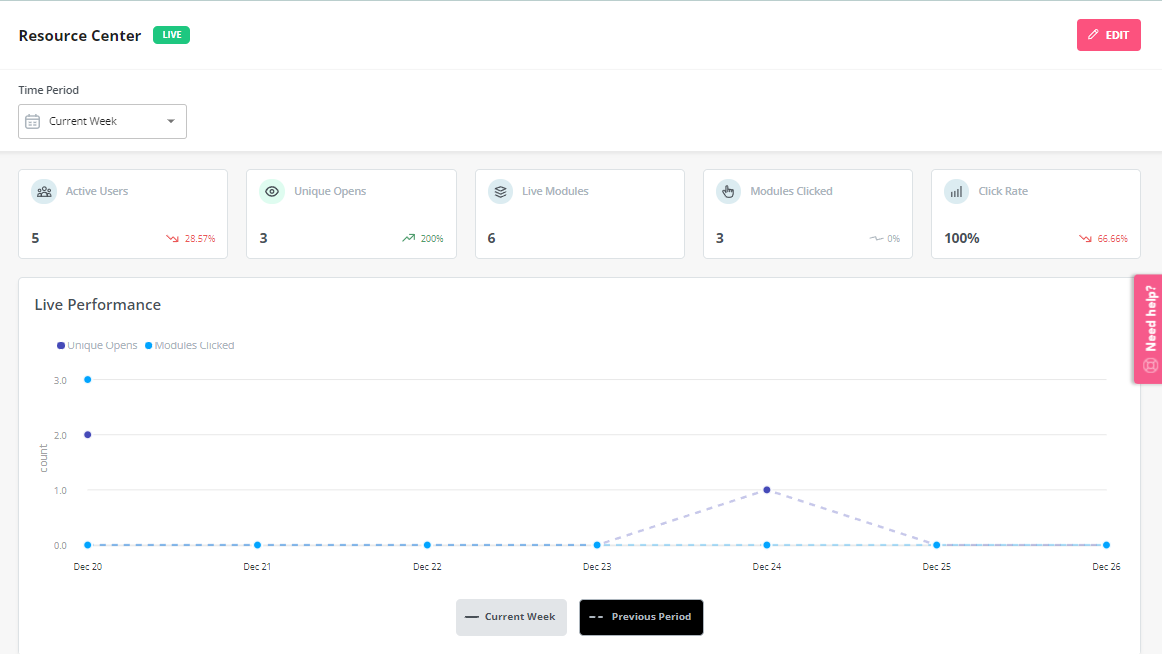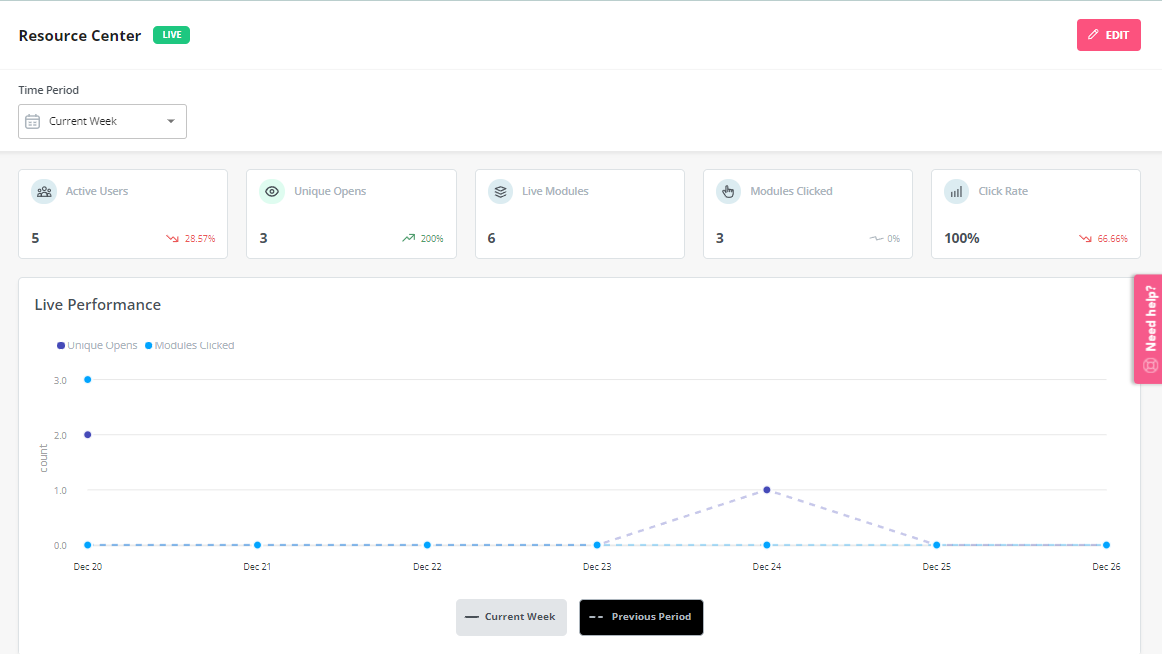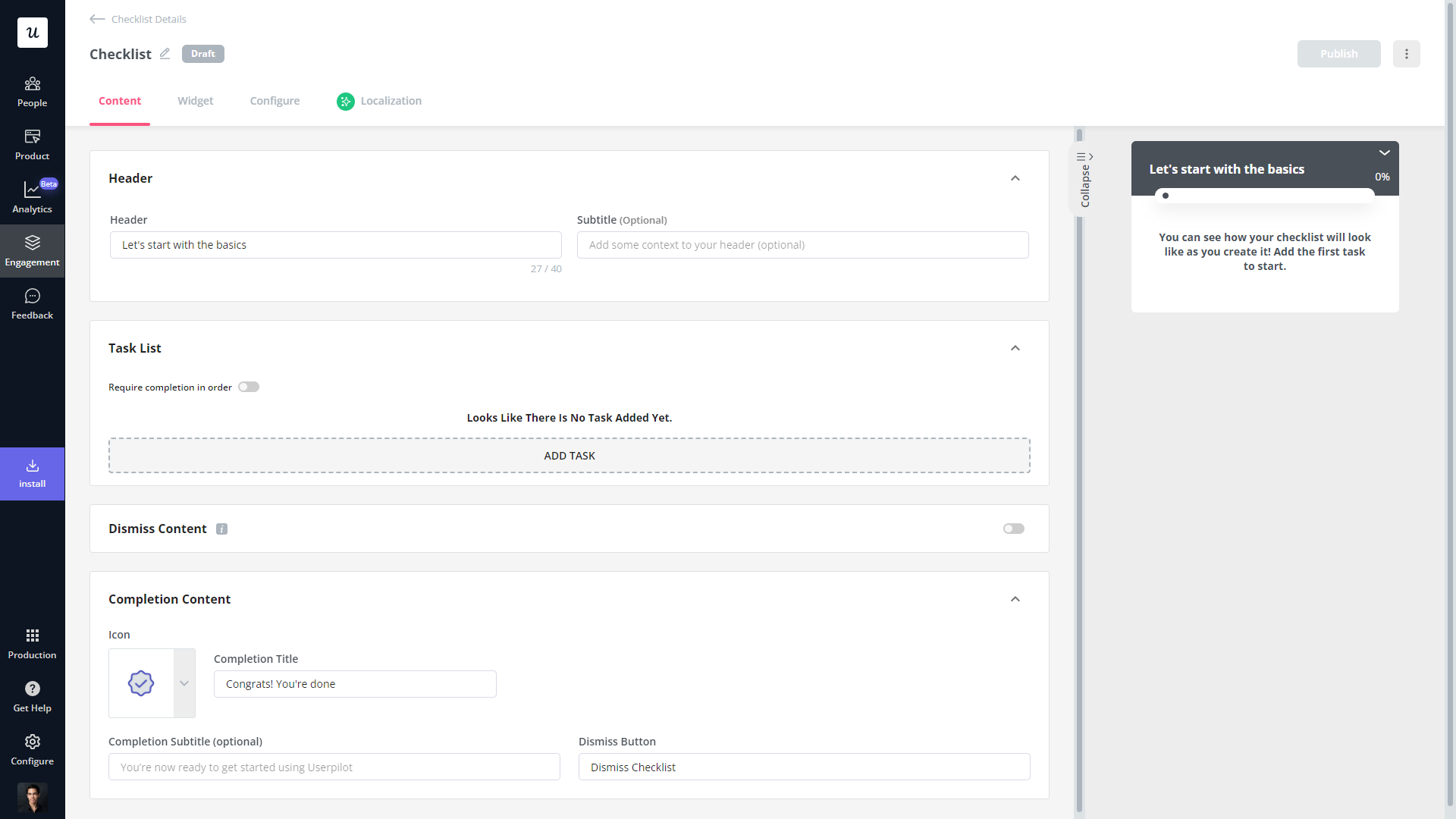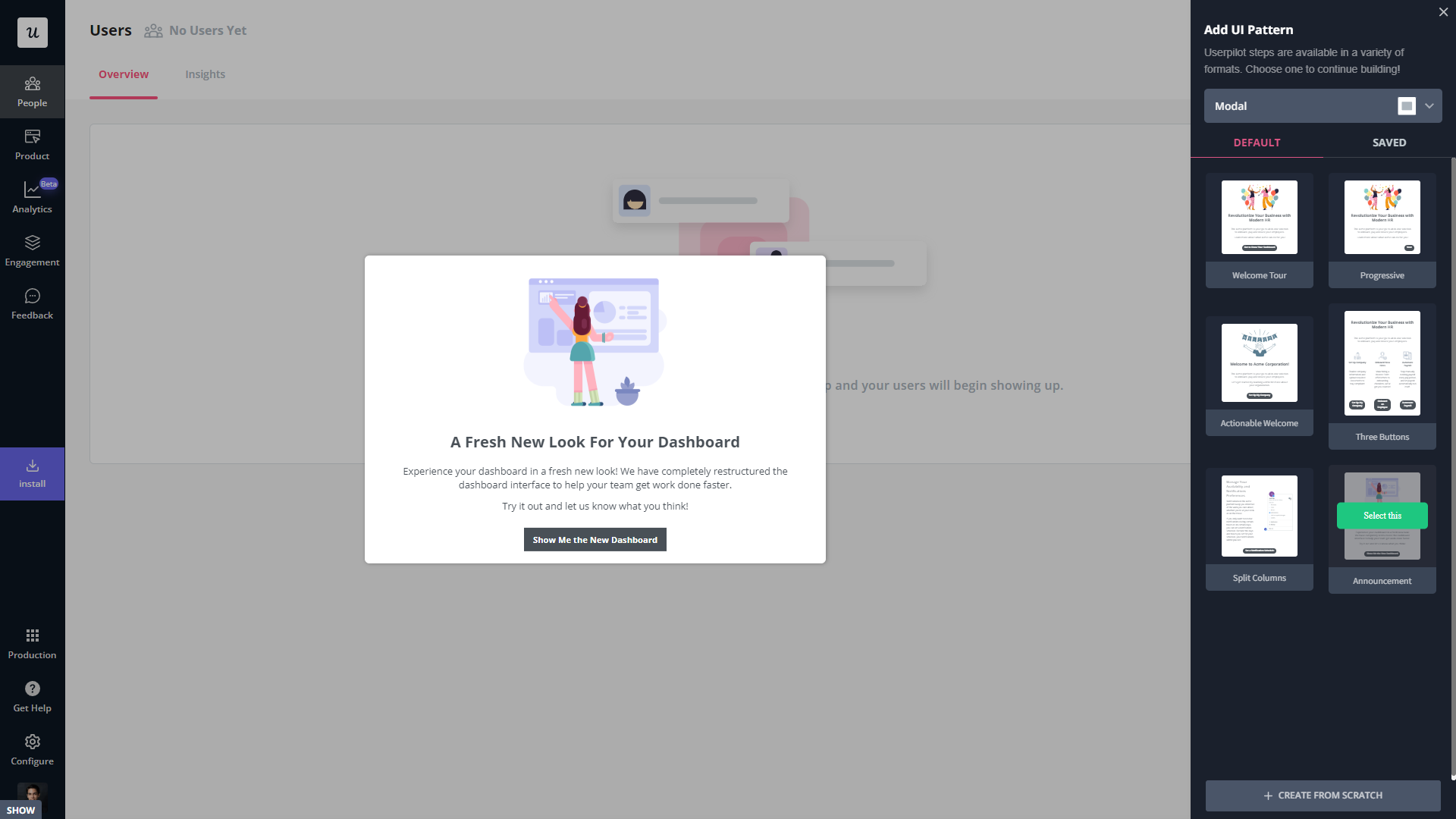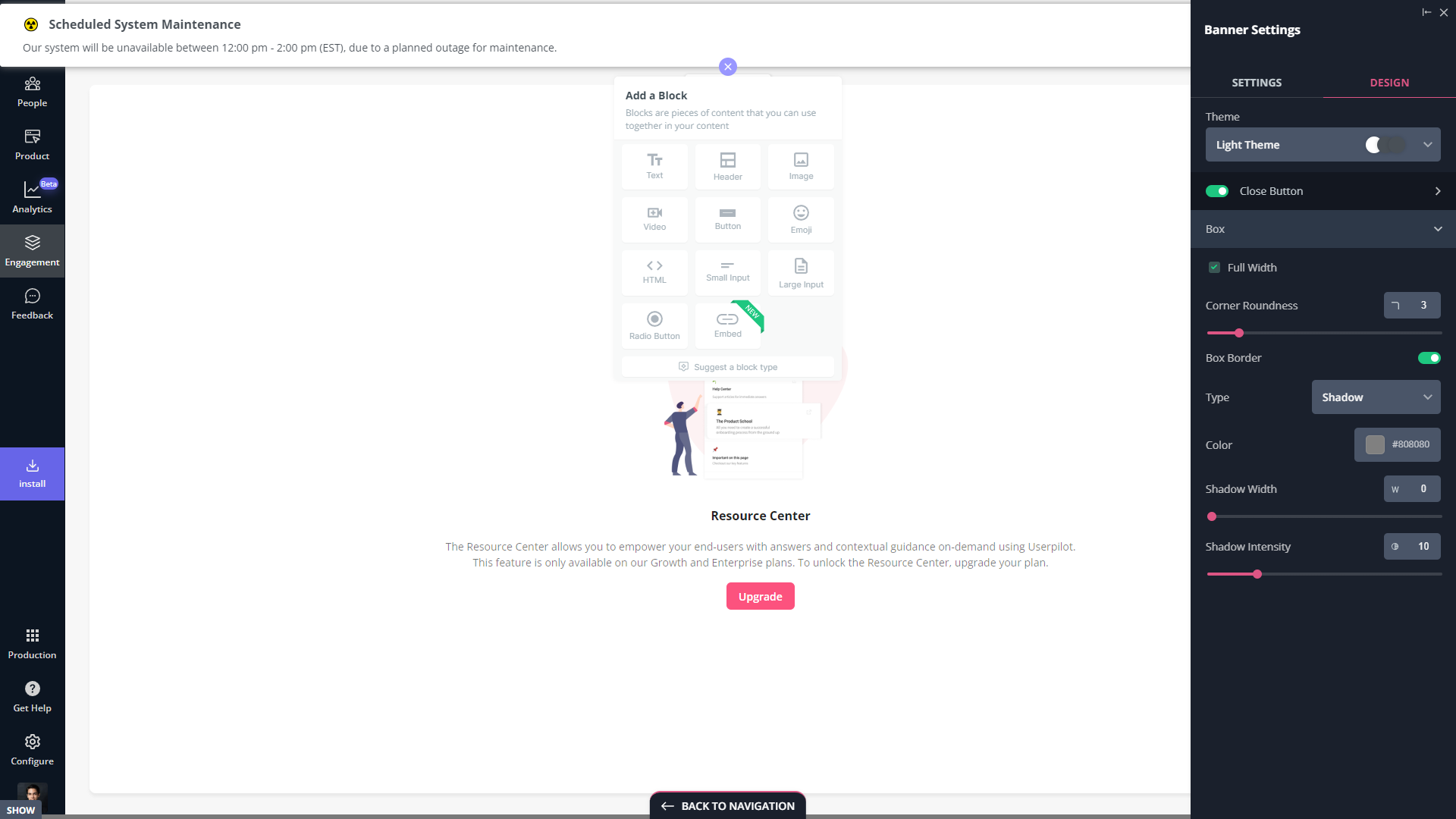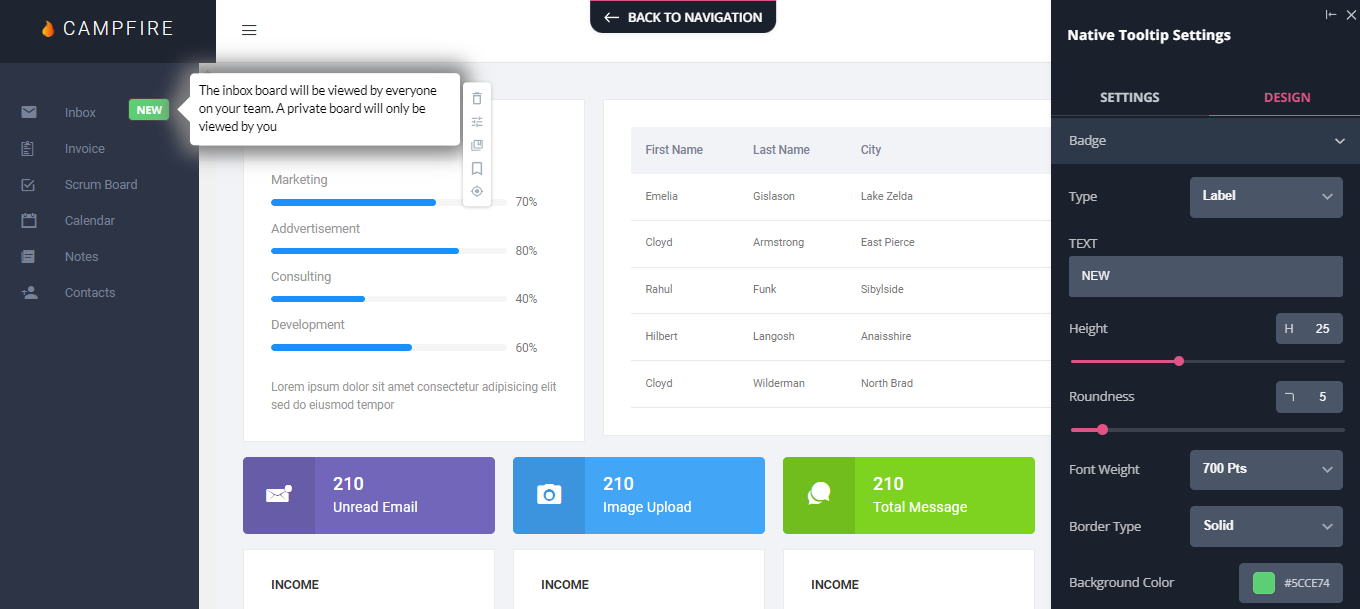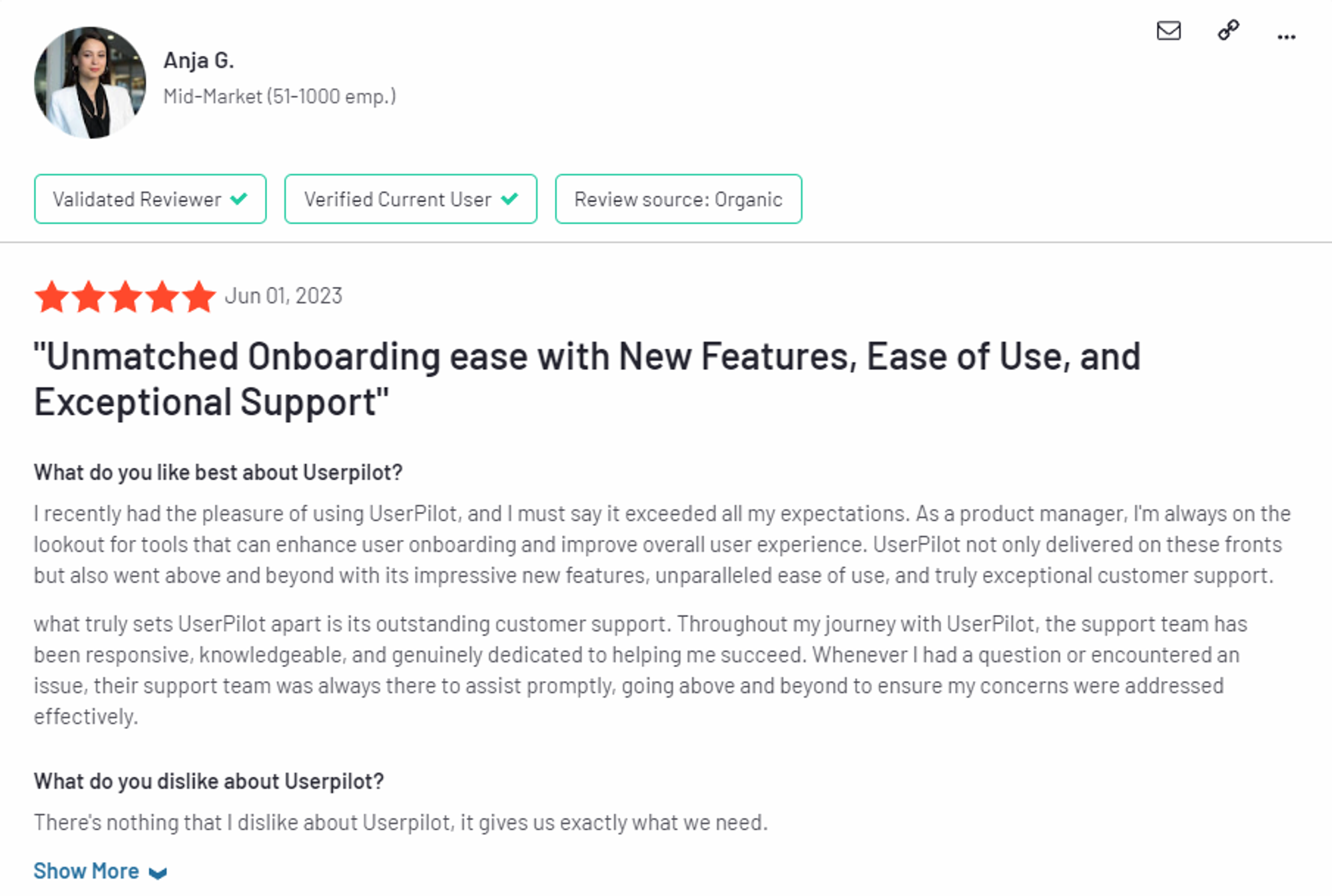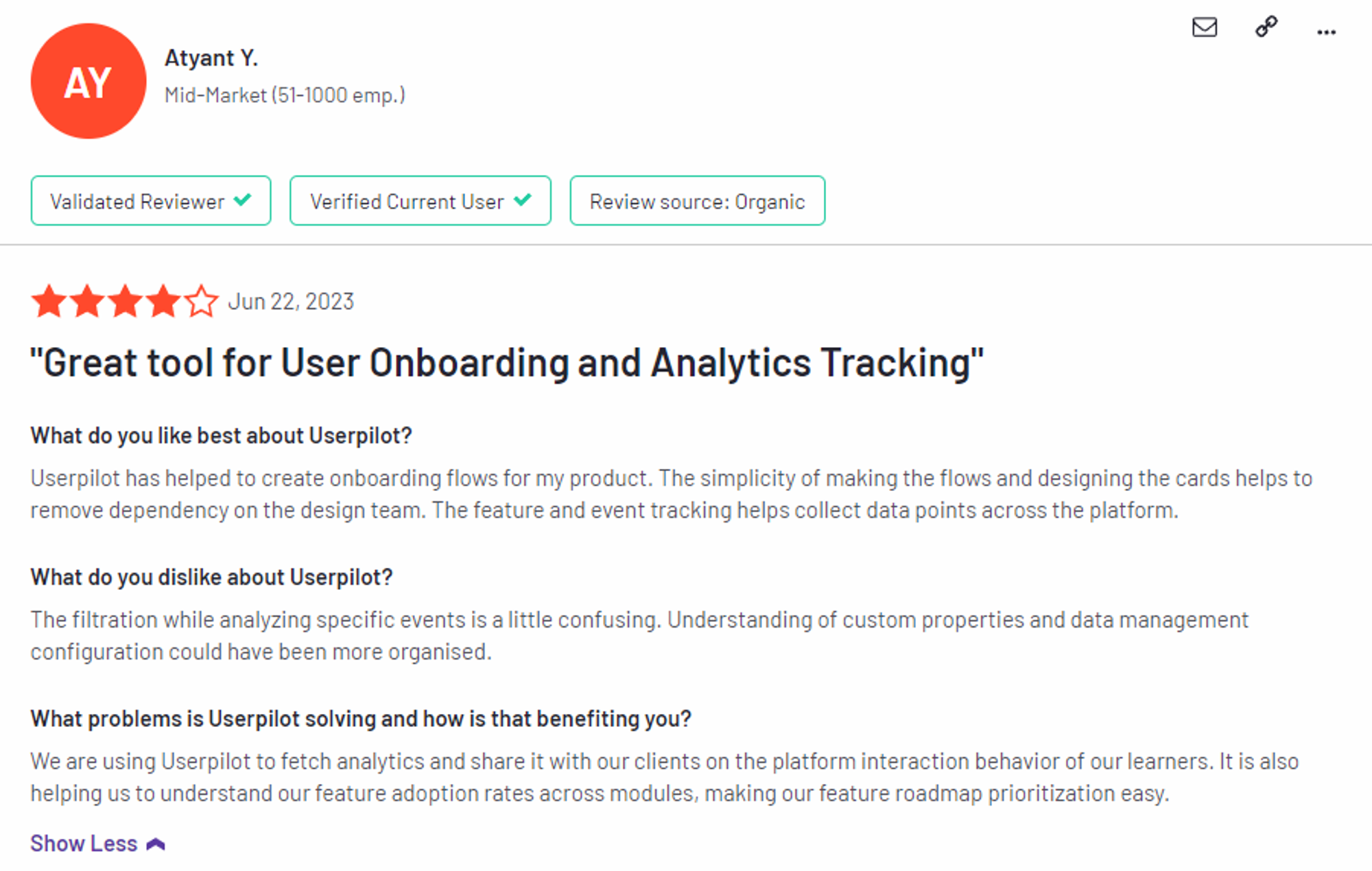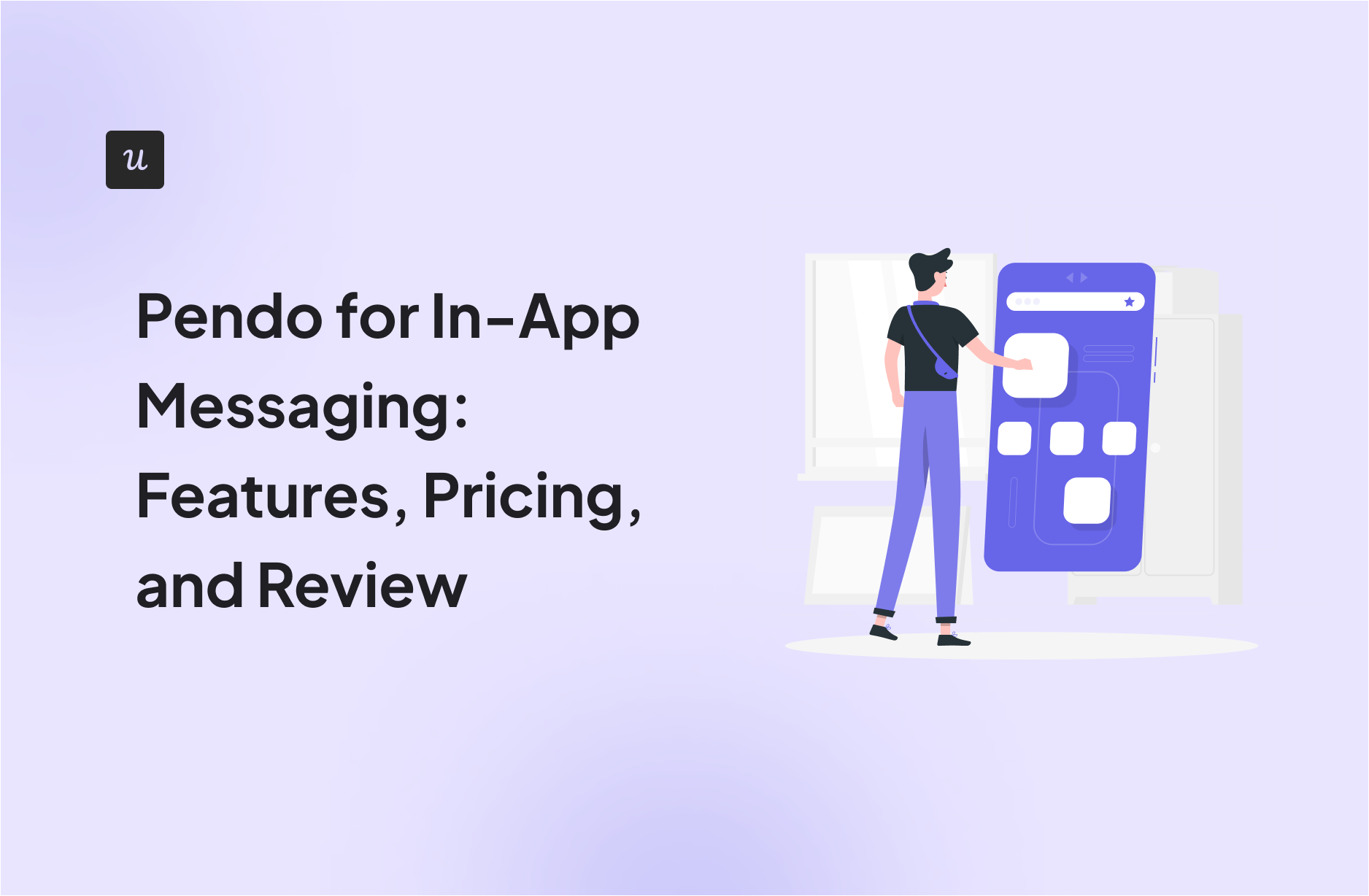
In-app support includes everything from chatbots to product documentation and the human representatives on your support team who respond to live chat requests. Implementing in-app support elements in your product can reduce the learning curve and cut down on support costs.
Here are three Pendo features you can use to improve in-app support:
- Intercom integration: Pendo’s integration with Intercom makes it possible to embed a live chat into your in-app resource center so users can get real-time support at any point in their product tour.
- In-app Resource Center: As an onboarding and product adoption solution, Pendo’s in-app resource center has most of the features you’d expect. Because it’s a native feature rather than an integration, most interactions with the Pendo in-app resource center will also reflect on your analytics dashboard.
Here are a few benefits of using Pendo’s in-app resource center feature:
- Segmentation: Pendo’s in-app resource center has segmentation settings that let you configure which documents a user can see. For instance, you could hide the onboarding module from users who have already completed the onboarding process.
- Analytics: You’ll be able to see the number of visitors your in-app resource center has gotten in the past month or week, as well as which modules are getting the most views or clicks overall.
- Integrations: Pendo supports multiple integrations that let you embed live chats and knowledge bases within the in-app resource center itself. These include tools like Intercom, Drift, Zendesk, Help Scout, and more.
Note: The Resource Center is not available on the Free plan but is included in all paid plans (Base/Core or higher).
-
Support tooltips: Tooltips are a proactive way to answer questions before users even ask them and deflect recurring support tickets, so your representatives have more time to work on complex cases.
Pendo’s Self Service Support
Here are the Pendo features to use for self-service support:
- Resource Center: Pendo’s in-app Resource Center can serve as a self-service portal with different modules for each stage of the user journey. Create a dedicated section for onboarding resources or segment the visible modules so users only see the most relevant guides.
- Tooltips: In addition to educating new users, tooltips can also be used to link to product documentation, onboarding resources, and tutorial videos that will help your customers solve their own problems.
- Live Chat integrations: When you integrate your Pendo account with either Drift or Intercom, you’ll be able to embed a live chat widget within the in-app Resource Center. This is very helpful for customers who try to solve a problem themselves but realize they need real-time assistance.
Note: You’ll need to upgrade to the Base or above plan to use Pendo integrations and resource centers.
Pendo’s in-app Resource Center
Pendo’s Resource Center looks impressive on the surface, but it comes with caveats. It’s not available on the Free plan at all, and while you can access it on paid plans, the flexibility you get is fairly limited unless you’re on higher tiers.
Here’s a closer look:
- Segmentation: Pendo’s Resource Center lets you combine static rules (e.g. account status) with dynamic, behavior-based criteria (e.g. completed feature clicks) to drive highly personalized content.
- Analytics: There are some high-level stats like visitor count and top-viewed modules, but it’s pretty barebones. Don’t expect funnel-level insights or goal tracking inside the Resource Center itself.
- Integrations: Yes, you can embed third-party chat tools like Intercom or Drift, but only once you upgrade. And there’s no native chatbot or knowledge base option – everything depends on external tools.
Note: You won’t get access to the Resource Center or integrations unless you’re on a paid plan (Base or higher). That makes it a no-go for startups or teams looking for freemium value.
Pendo’s onboarding checklist
Pendo’s Checklists are created through the Guides module, not the Resource Center. While you can display checklists inside a resource center as modules, you can also launch them as standalone experiences.
Here are a few Pendo settings you can use to optimize your onboarding checklists:
- Segmentation: Pendo recommends that onboarding checklists be segmented so that users only see them within the first 30 days of their initial product interaction. This ensures that it won’t clutter the UI of proficient users who no longer need onboarding assistance.
- Analytics: All interaction data for your onboarding checklist can be found under the Guides analytics tab in your Pendo account. You’ll be able to see the total number of views, visitors, and clicks, along with which segment the checklist is visible for.
- Triggers: Because checklists are created as part of Guides, you can trigger them based on user actions like custom events or feature clicks. This lets you show the checklist when it’s contextually relevant to the user’s behavior.
Pendo’s in-app messaging
In-app messaging is one of the most effective ways to engage with active users with the goal of educating, retaining, or upselling them. Most in-app messaging flows are comprised of tooltips, modals, or a combination of the two.
Here are Pendo in-app messaging features you can use to connect with your users:
- Lightboxes: Lightboxes are Pendo’s take on modals. Certain lightboxes can prevent users from interacting with the product until the in-app message has been dismissed, so these intrusive popups should be reserved for important notifications.
- Tooltips: Instead of taking up large swathes of the screen, tooltips are small text snippets that show up next to a button or feature to provide additional context. These can help users discover new features or figure out where to go next after completing a product tour.
- Banners: While not as commonly used as lightboxes and tooltips, Pendo banners are another in-app messaging option that you can use. These show up at the top of the screen and can be used as a less-intrusive alternative to lightboxes as they don’t restrict product interaction.
- User Guides: Pendo’s User Guides are multi-step, interactive walkthroughs designed to onboard users, introduce new features, or drive specific workflows. These guides can be personalized and segmented to deliver the right message to the right user at the right time, helping improve adoption and reduce churn.
- Interstitials: Interstitials are full-screen messages or pop-ups that appear between user actions or at key moments in the user journey. They are effective for delivering important announcements, promotions, or calls to action that require user attention before proceeding.
- Surveys: Pendo supports in-app surveys embedded within guides or as standalone messages. These include polls, NPS surveys, and multiple-choice questions that help you collect user feedback directly within the product experience. While customization options are somewhat limited, surveys are a powerful way to gauge sentiment and gather actionable insights.
Get The Insights!
The fastest way to learn about Product Growth, Management & Trends.
What are the pros and cons of Pendo?
Pendo’s pros
Let’s take a look at some of the benefits of using Pendo:
- No-code: Pendo lets you create surveys, in-app guides, and track metrics without needing to write your own code, which saves a lot of time (while making product experiments or split-testing a lot easier).
- Custom themes: Pendo’s themes let you create multiple palettes and ensure that any in-app materials published align with your existing brand palette (however, you can only create/customize themes after you’ve installed the Pendo snippet).
- Flexible dashboards: Pendo has plenty of widgets that you can add to your dashboard, including feature adoption, Net Promoter Score, poll results, guide engagement, product stickiness, and MAUs, so you always have your most important metrics within reach.
- Integrations: Pendo has 50 different integrations to choose from, including popular tools like Intercom, Jira, Okta, and HubSpot. It supports bi-directional data sync with platforms such as Salesforce, HubSpot, Workato, and Zendesk.
-
Multi-platform analytics: Because Pendo is compatible with mobile applications, you’ll be able to track product analytics for both web apps and mobile apps. This gives you a more holistic view of how users (or specific segments) use your product on different platforms.
Pendo’s cons
While Pendo certainly has quite a few benefits that make it an appealing solution, there are also a few notable drawbacks that you should be aware of before you choose the platform as your product adoption tool:
- Pricing jumps: While Pendo does offer a free version, it has a limit of 500 MAUs. Upon reaching the MAU limit, you’ll need to upgrade to continue using most of Pendo’s features (and paid plans tend to cost thousands of dollars per month).
- Locked features: Key features like the data explorer, resource center, and product engagement score are locked behind the Base or Core plan.
- Data lag: Pendo’s analytics dashboards only update once per hour. In some cases, this data lag could lead product teams to make the wrong decisions or draw false conclusions from outdated insights.
What do users say about Pendo?
Most Pendo users seem to be quite happy with the solution despite a few personalization roadblocks and usability challenges:
I love the ability to see where our users are spending the bulk of their time. I love the ability to measure metrics quantitatively.
Other users were less satisfied with Pendo as a product adoption solution due to the amount of effort it takes to actually use the tool on a regular basis:
I’m giving a 1 so unfortunately I can’t give much love. It’s already my second job using Pendo and I’m not impressed. A/B testing numbers are different between the API export and CSV export in the UI, no 50/50 split between test and control, support is slow, event tracking doesn’t handle aliasing, only 7 days of historical data can be sent with Segment which make backfills impossible, NPS forms are shown in multiple tabs and doesn’t close once it’s been submitted in one of the tab.
Pendo’s pricing
Pendo’s pricing can feel like a bit of a mystery. Except for the Free plan, pricing details for their paid plans are not publicly listed, so you’ll need to contact their sales team for a custom quote. Pendo has four paid plans and one free version that is limited to 500 MAUs which makes it accessible to startups but difficult to scale in the long run.
According to Vendr, Pendo’s pricing range varies from $15,900 to $140,091.This varying pricing structure can make it challenging for startups and growing companies to budget confidently.
Here’s the difference between each Pendo plan:
- Pendo Free: The free version of Pendo can accommodate up to 500 monthly active users (MAUs) and has basic features like product analytics (behavioral & retroactive), in-app guides (web & mobile), roadmaps, branded NPS surveys, guide scheduling & ordering.
- Base plan: Pendo’s Base plan is suitable for small to mid-sized companies beginning their product experience journey with customization and support. This plan includes everything you get in the Free plan, plus: custom MAU limits, customer support, product engagement score (PES), customizable reports, resource Center (single), cross-app journey reports, and executive dashboards (limited), API access, and 1 integration.
- Core plan: Pendo’s plan is targeted towards growing businesses that need deeper user insights and experimentation capabilities. Features include all Base plan features, plus: session replay and playback, guide experiments (A/B testing), frustration indicators (rage clicks, error clicks), unlimited session capture
- Pulse plan: The Pulse plan is designed for scaling businesses and mid-to-large enterprises that want to optimize their product investments. It includes everything in the Core plan plus advanced features like white-labeled NPS surveys, idea validation and prioritization tools, a customer feedback portal, automated feedback triaging, Jira integration, and detailed feedback insights and summaries. This plan helps teams collect and analyze user feedback more effectively and align product development with customer needs.
- Ultimate plan: The Ultimate plan is Pendo’s most comprehensive offering, built for large enterprises requiring full-scale product analytics and automation. It includes all the features of the Pulse plan, plus the Pro edition of in-app guides with advanced customization, journey orchestration, data synchronization across systems, and unlimited resource centers.
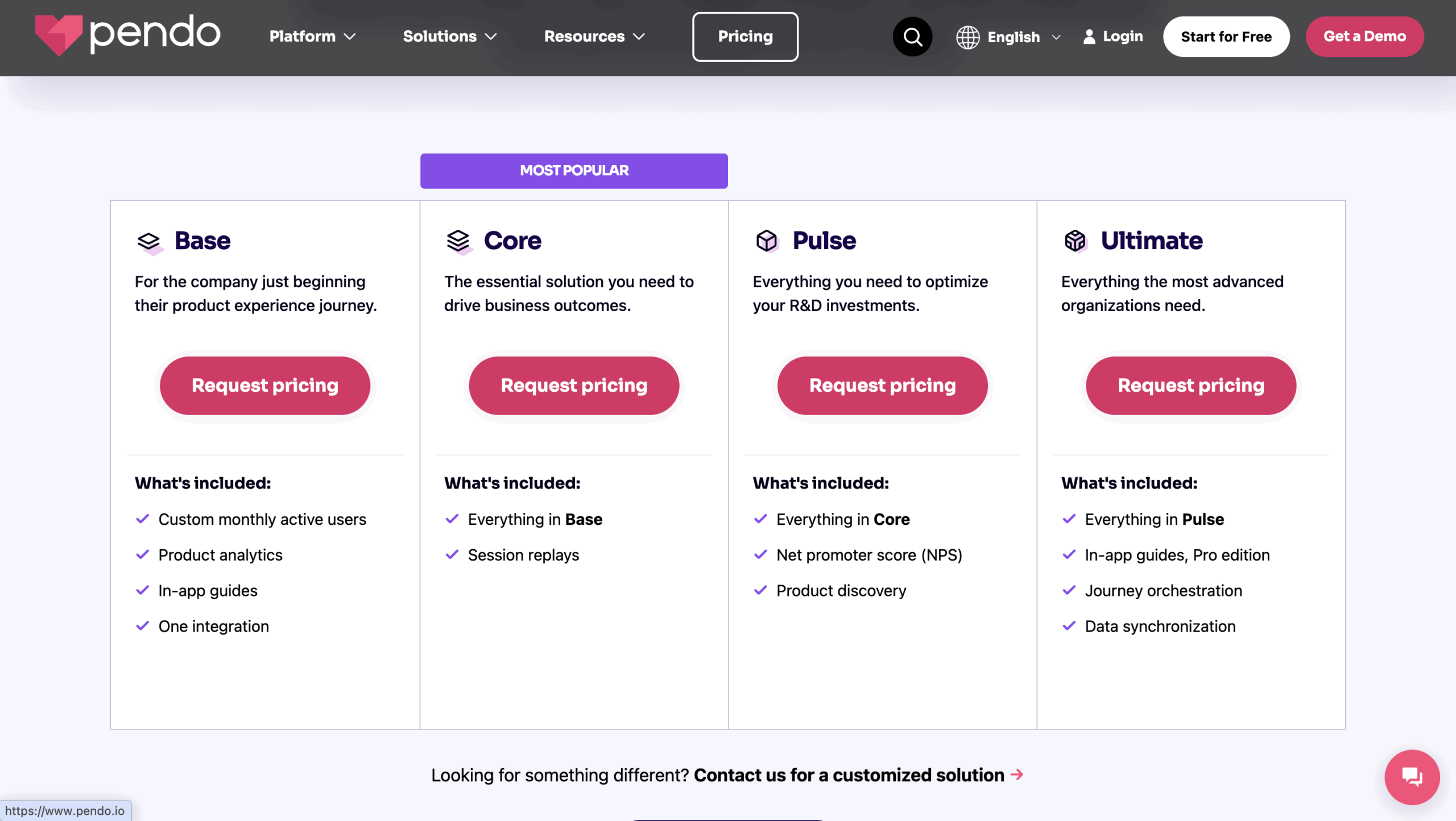
3 Reasons why you might need a Pendo alternative
There are a few obvious instances where you’ll likely need an alternative solution to Pendo, such as these use cases:
- Over 500 MAUs: If your product has more than 500 MAUs then you’ll need to subscribe to a premium Pendo plan (which tends to be significantly more expensive than other competitors on the market).
- Real-time analytics needs: Companies that operate in fast-paced work sprints will likely opt for product adoption solutions with real-time analytics since Pendo’s one-hour data lag can make data-driven decision-making difficult.
- Expensive pricing model: Pendo is more expensive than most solutions on the market and the subscription cost rises rapidly as your MAUs grow. Even if you’re on the Base plan, you could be paying up to $35,000 annually once you reach 10,000 MAUs, which makes it harder to scale.
Userpilot – A better alternative for in-app messaging
In-app support can increase customer satisfaction and retention rates. Userpilot has native in-app support features like resource centers and native tooltips, as well as third-party integrations with popular support tools like Intercom to help you cover all your bases.
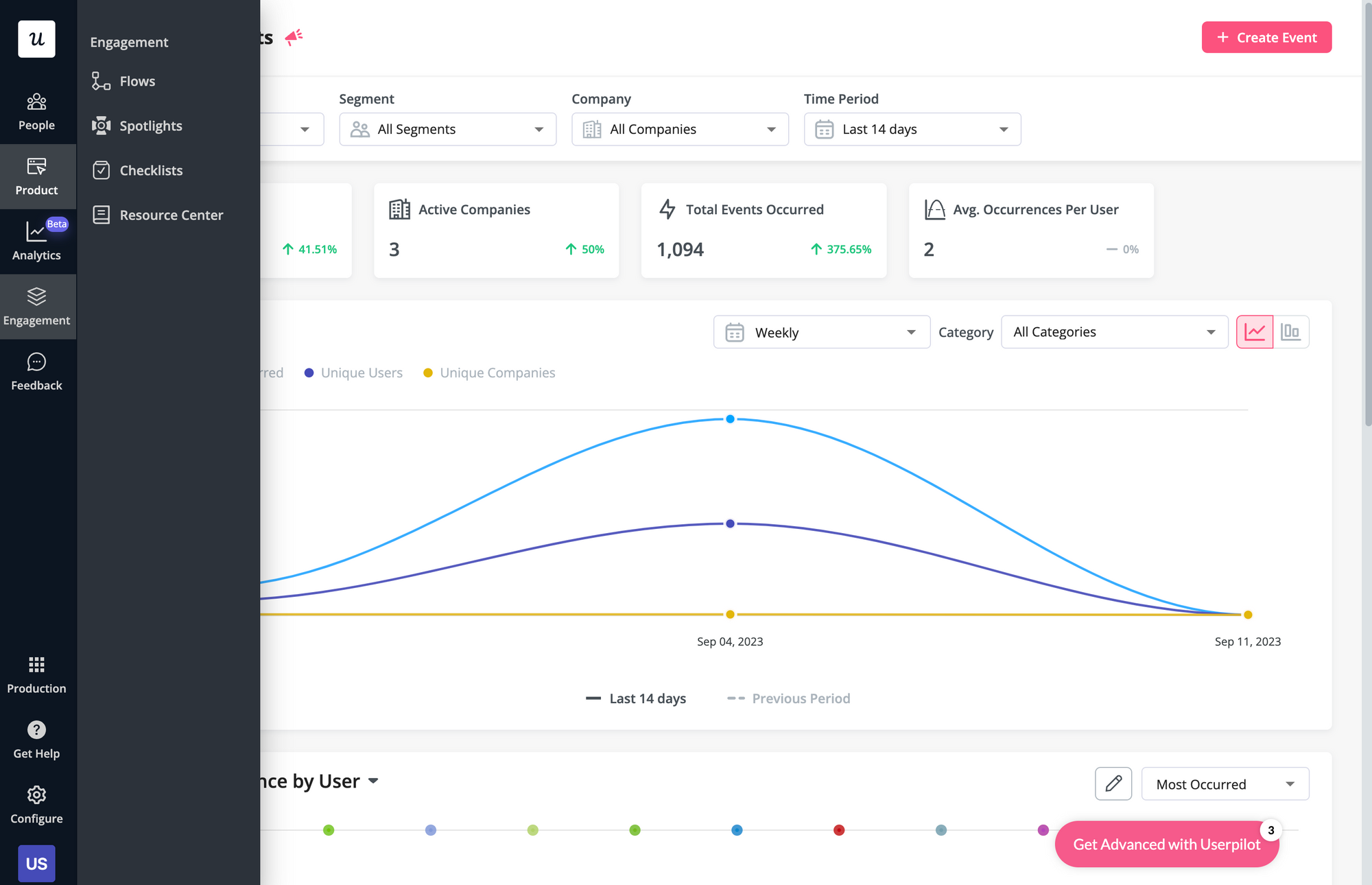
-
Resource center: Userpilot in-app resource centers let you add flows, checklists, external links, tutorial videos, external knowledge bases, and chatbots. You’ll also be able to view resource center analytics so you can check its performance.
-
Native tooltips: In-app support must be proactive, which is why you should insert tooltips that guide users before they even think to open the resource center. Userpilot lets you add native tooltips that appear whenever users hover over an element or click on the info badge.
-
Contextual flows: Userpilot’s trigger settings let you create contextual flows that automatically appear when a user reaches a certain page or performs a specific action. This can be used to offer in-app guidance and support whenever users try out a feature for the first time.
-
Intercom integration: While is famous for its live chat embeds, you can do more than that by integrating it with Userpilot. You’ll see which events a user has done within Userpilot and whether or not they’ve completed onboarding to personalize support accordingly.
Userpilot’s self service support
Self-service support helps users solve problems themselves instead of having to reach out to a representative. Userpilot’s no-code resource center makes onboarding guides and product documentation easily accessible to users from within your product.
Here’s how you can use Userpilot to create a self-service customer experience:
- No-code builder: Userpilot’s no-code resource center lets you add modules without writing a single line of code. Module options include links, videos, flows, custom JavaScript functions, and checklists. You can also group modules into sections to help users navigate the resource center.
-
Module segmentation: Userpilot’s segmentation settings let you hide or show specific modules within your resource center based on audience settings. This makes it possible to create modules for different user segments and hide resources that aren’t relevant to other users.
-
Analytics dashboard: The dedicated analytics dashboard helps you see how many unique visitors your resource center gets, how many modules have been clicked, and the overall click rate across your user base. This will make it easier to gauge resource center performance.
Userpilot’s in-app resource center
In-app resource centers help users find answers to their questions without needing to leave your product. Userpilot’s resource centers leverage advanced segmentation to target specific customers or use cases, have detailed analytics, and can be built using the no-code editor.
Here’s a closer look at Userpilot’s resource center editor:
- No-code editor: Userpilot lets you build in-app resource centers without needing to write any code. You can add modules like internal/external links, tutorial videos, in-app flows, custom JavaScript functions, and checklists, or group multiple modules into a single section.
-
Targeted modules: Userpilot’s module segmentation features let you show/hide specific resources depending on which segment a user is in. This helps you personalize your in-app resource center and only show the resources that are most relevant to a particular user.
-
Analytics dashboard: Userpilot’s resource center analytics can show you key metrics like the total number of visitors, how many modules have been clicked, and changes in the click rate to help you gauge performance. You can also sort data by a specific time period if needed.
Userpilot’s onboarding checklist
Onboarding checklists help new users learn about a product and reduce their time-to-value (TTV). Userpilot checklists can be created using the no-code builder, used to trigger specific actions, and tracked using the analytics dashboard to gauge overall engagement.
Here’s how you can use Userpilot to create an advanced onboarding checklist:
-
No-code builder: Userpilot’s checklist creator lets you edit the content of checklists, add tasks, style icons, and configure the triggers for when your checklist should appear. You’ll also be able to choose from five widget icons (or upload your own) and recolor the widget to match your UI.
-
Smart tasks: Checklist tasks can be set to trigger specific actions upon being completed, such as redirecting a user to a different page, launching an in-app flow, or running a custom JavaScript function. You can also set the conditions for when a task and action will be marked as complete.
-
Checklist analytics: The Checklists dashboard shows you all relevant metrics. These include the number of live checklists you have, how many views they’ve gotten, and how many have been completed. You can also sort these analytics by segment or time period to identify trends.
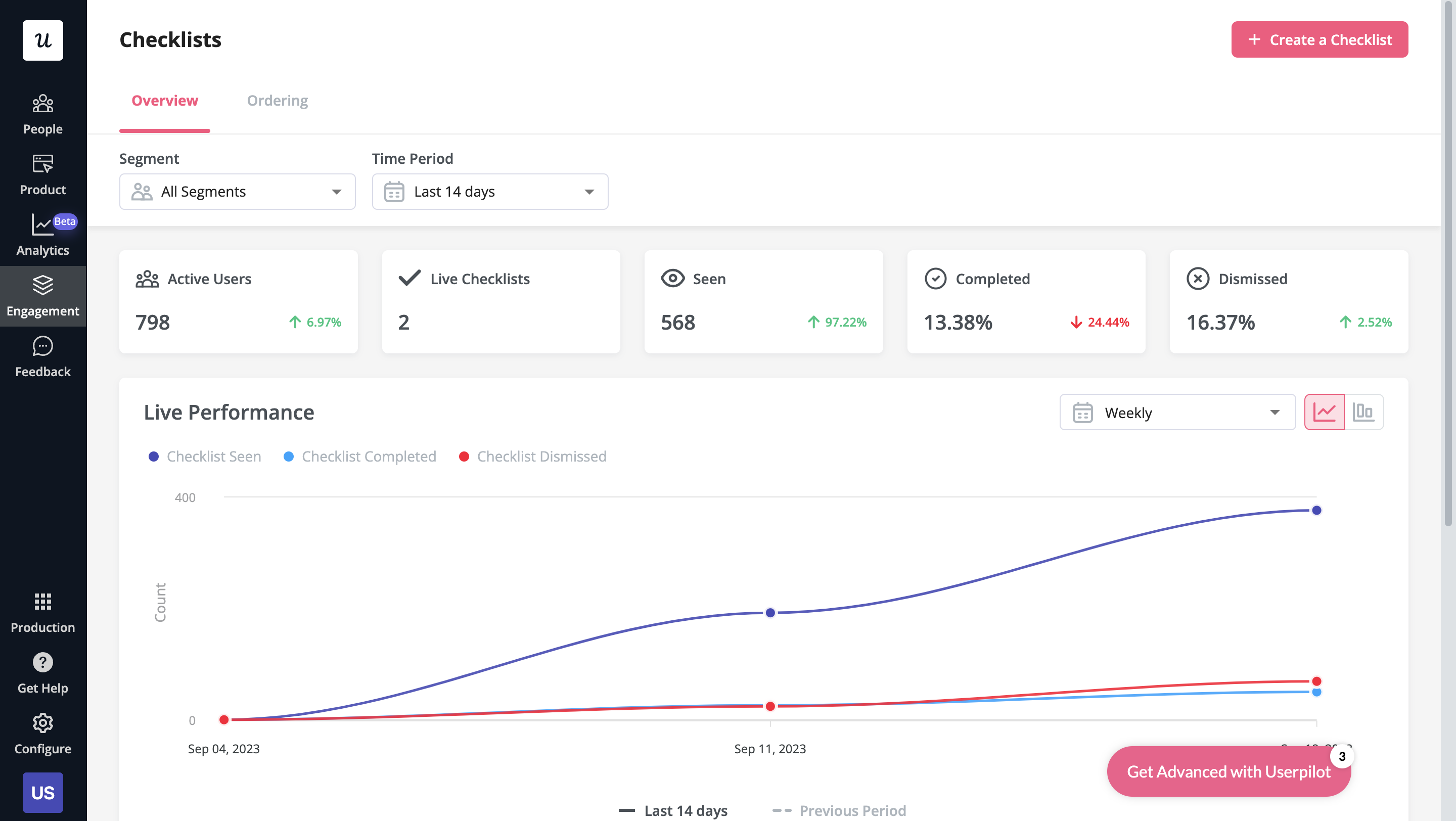
Userpilot’s in-app messaging
In-app messaging enables communication within your product to onboard new users or drive feature adoption among existing customers.
Here are a few ways you can send in-app messages using Userpilot:
- Modals: Userpilot lets you use modals to send unmissable in-app messages to your users. Simply choose from one of the six templates or create a new modal from scratch. You’ll be able to use text, emojis, images, and videos to help your modals get the message across to users.
-
Banners: Userpilot banners can be used to send in-app messages that are urgent but don’t need to take up the entire screen. You can also add blocks with text, emojis, images, videos, forms, custom JavaScript functions, and more to style banners to your liking.
-
Tooltips: They are the least intrusive form of in-app messaging as they only show up when users hover over an element or click on an info icon. You’ll be able to adjust the height, shape, color, and placement of tooltips to make them native-like.
What are the pros and cons of Userpilot?
Userpilot’s pros
As a full-suite digital adoption platform, Userpilot has all the features you need to onboard users, track analytics, and gather feedback from customers without writing a single line of code. Here are a few pros of using Userpilot as your product growth solution:
- No-code builder: Userpilot’s Chrome extension lets you build flows, add UI elements, and tag features without writing a single line of code.
- UI patterns: There are plenty of UI patterns to choose from when using Userpilot such as hotspots, tooltips, banners, slideouts, modals, and more!
- Startup-friendly: Userpilot’s entry-level plan gives you access to all available UI patterns so you can hit the ground running.
- Walkthroughs and flows: Build engaging interactive walkthroughs and personalized onboarding flows that target specific segments of your user base.
- Self-service support: Build an in-app resource center to help users solve problems, customize its appearance to align it with your brand, and insert various types of content (videos, flows, or chatbots) to keep your customers satisfied.
- A/B testing: Userpilot’s built-in A/B testing capabilities will help you split-test flows, iterate on the best-performing variants, and continually optimize based on user behavior.
- Feedback collection: Userpilot has built-in NPS surveys with its own unified analytics dashboard and response tagging to help you retarget users. There are other survey types to choose from, and you can even create your own custom survey.
- Survey templates: There are 14 survey templates to choose from so you can gather feedback on specific features or run customer satisfaction benchmarking surveys like CSAT and CES.
- Advanced analytics: Userpilot lets you analyze product usage data, monitor engagement on all in-app flows, and use the data to create user segments that are based on behaviors instead of demographics.
- Event tracking: Userpilot’s no-code event tracking lets you tag UI interactions (hovers, clicks, or form fills) and group them into a custom event that reflects feature usage.
- Third-party integrations: Userpilot has built-in integrations with tools like Amplitude, Mixpanel, Kissmetrics, Segment, Heap, HubSpot, Intercom, Google Analytics, and Google Tag Manager so you can share data between all the solutions in your tech stack.
Userpilot’s cons
Of course, no tool is perfect and there are a few cons to consider before choosing Userpilot as your user onboarding or product growth solution:
- Employee onboarding: Currently, Userpilot only supports in-app customer onboarding.
- Freemium plan: There’s no freemium Userpilot plan so those bootstrapping their startup and need sub-$100 solutions should consider more affordable onboarding platforms like UserGuiding or Product Fruits.
What do users say about Userpilot?
Most users laud Userpilot for its versatile feature set, ease of use, and responsive support team:
I recently had the pleasure of using Userpilot, and I must say it exceeded all my expectations. As a product manager, I’m always on the lookout for tools that can enhance user onboarding and improve overall user experience. Userpilot not only delivered on these fronts but also went above and beyond with its impressive new features, unparalleled ease of use, and truly exceptional customer support.
What truly sets Userpilot apart is its outstanding customer support. Throughout my journey with Userpilot, the support team has been responsive, knowledgeable, and genuinely dedicated to helping me succeed. Whenever I had a question or encountered an issue, their support team was always there to assist promptly, going above and beyond to ensure my concerns were addressed effectively.
Source: G2.
Of course, other users are also kind enough to share constructive criticism regarding specific features like event tracking filters:
The filtration while analyzing specific events is a little confusing. Understanding of custom properties and data management configuration could have been more organised.
Source: G2.
Userpilot’s pricing
Userpilot offers transparent pricing tailored to the needs of growing SaaS companies and larger enterprises, with plans starting at $299/month and scaling to custom Enterprise tiers.
All paid plans include access to key features for driving product adoption, and even the entry-level Starter plan provides full access to all UI patterns, making it a strong fit for most mid-market SaaS businesses.
Here’s a breakdown of the three paid plans:
- Starter – $299/month (billed annually): The Starter plan is available if you commit to an annual subscription. It includes essential features like segmentation, product analytics, reporting, user engagement, NPS feedback, and customization.
- Growth – Starting at $799/month: The Growth plan adds more advanced capabilities such as resource centers, event-based triggers, unlimited feature tagging, AI-powered content localization, EU hosting options, and a dedicated customer success manager.
- Enterprise – Custom quote: Designed for larger organizations, the Enterprise plan includes everything from Starter and Growth, along with enterprise-grade functionality like custom roles and permissions, premium integrations, priority support, custom contracts, SLAs, SAML SSO, activity logs, security audits, and compliance features (SOC 2, GDPR).

Conclusion
There you have it.
It should be easier now to make an informed decision whether Pendo is your go-to option for in-app messaging. Ultimately, the best choice will depend on your product and current needs.
If you’re looking for a better alternative to Pendo for in-app messaging, book a Userpilot demo today to experience firsthand how it can enhance your user experience and drive product growth!
Userpilot strives to provide accurate information to help businesses determine the best solution for their particular needs. Due to the dynamic nature of the industry, the features offered by Userpilot and others often change over time. The statements made in this article are accurate to the best of Userpilot’s knowledge as of its publication/most recent update on May 9, 2025.


